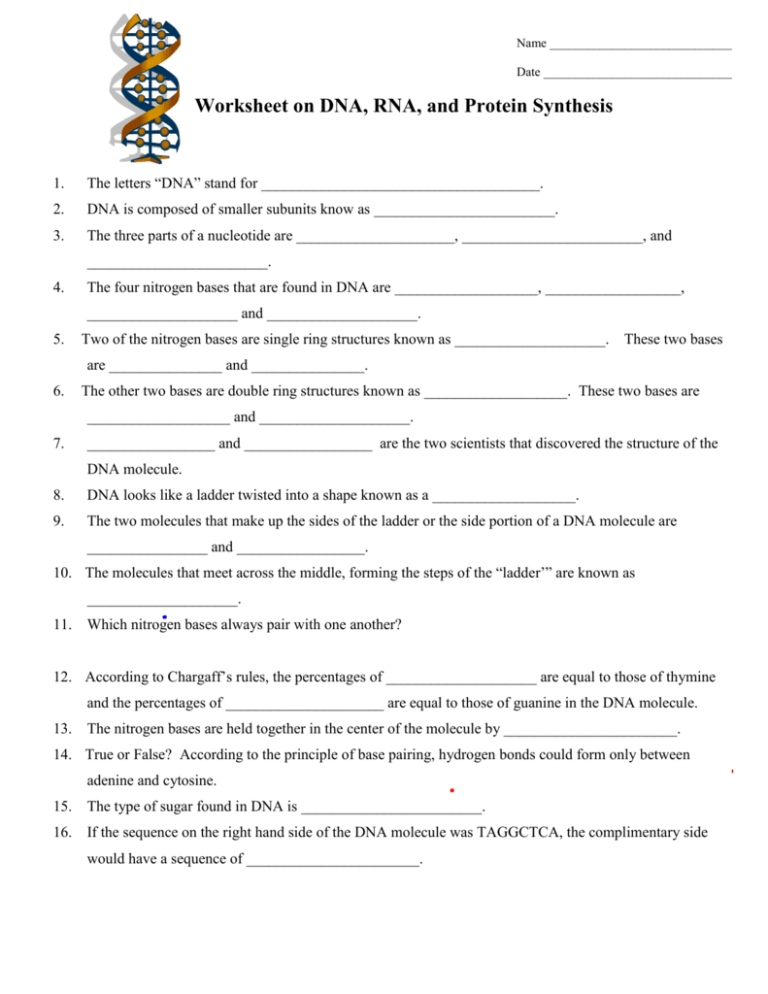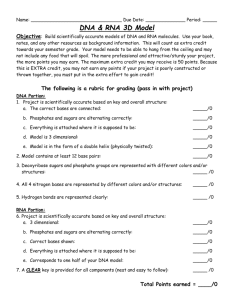Worksheet on DNA and RNA
advertisement

Name _____________________________ Date ______________________________ Worksheet on DNA, RNA, and Protein Synthesis 1. The letters “DNA” stand for _____________________________________. 2. DNA is composed of smaller subunits know as ________________________. 3. The three parts of a nucleotide are _____________________, ________________________, and ________________________. 4. The four nitrogen bases that are found in DNA are ___________________, __________________, ____________________ and ____________________. 5. Two of the nitrogen bases are single ring structures known as ____________________. These two bases are _______________ and _______________. 6. The other two bases are double ring structures known as ___________________. These two bases are ___________________ and ____________________. 7. _________________ and _________________ are the two scientists that discovered the structure of the DNA molecule. 8. DNA looks like a ladder twisted into a shape known as a ___________________. 9. The two molecules that make up the sides of the ladder or the side portion of a DNA molecule are ________________ and _________________. 10. The molecules that meet across the middle, forming the steps of the “ladder’” are known as ____________________. 11. Which nitrogen bases always pair with one another? 12. According to Chargaff’s rules, the percentages of ____________________ are equal to those of thymine and the percentages of _____________________ are equal to those of guanine in the DNA molecule. 13. The nitrogen bases are held together in the center of the molecule by _______________________. 14. True or False? According to the principle of base pairing, hydrogen bonds could form only between adenine and cytosine. 15. The type of sugar found in DNA is ________________________. 16. If the sequence on the right hand side of the DNA molecule was TAGGCTCA, the complimentary side would have a sequence of _______________________. 17. Label the parts of the drawing below. Include all of these terms: nucleotide, phosphate, sugar, nitrogen base, hydrogen bond, covalent bond, purine, pyrimidine, hydroxyl group, the 5’ end, the 3’ end, adenine, thymine, cytosine, and guanine. 18. The process in which DNA builds an exact duplicate of itself is known as _______________________. 19. What is the primary function of DNA? 20. Why is it so important that the DNA molecule be able to make copies of itself? 21. During replication, the two nucleotide chains _______________ and each chain serves as a ________________ for a new nucleotide chain. The sites where DNA replication and separation occur are called _______________________. 22. During replication, enzymes called ____________________ untwist the double helix, separating the two parental strands. The point at which the two chains separate is known as the _______________________. 23. Enzymes called ____________________________ move along the separated strands assembling the new chains of DNA. 24. True or False? The replication of DNA begins at one end of the molecule and proceeds to the other end. 25. True or False? DNA replication occurs simultaneously at many sites along the molecule speeding up the process of replication. 26. When replication is complete, two ________ copies of the DNA molecule have been produced and the cell is ready to begin __________________________. 27. True or False? Each DNA molecule resulting from replication has one original strand and one new strand. 28. The process of replication is very accurate. There is about _____ error in every ___________ bases. A change in the nucleotide sequence is known as a ____________________. These errors may be caused when enzymes fail to “proofread “ properly, or they may be caused by outside sources such as ___________________________________________________________. 29. The letters “RNA” stand for ______________________________. 30. In RNA, adenine always pairs with the nitrogen base known as __________________. 31. List three ways that DNA is different from RNA: a) b) c) 32. There are three kinds of RNA. ______________________ carries the information from the nucleus to the ribosomes in the cytoplasm. ____________________ reads the message and binds to the specific _____________________ to make the protein. ___________________ is the most abundant form of RNA and makes up ribosomes. 33. The process of making a strand of RNA from a strand of DNA is called ___________________. 34. __________________________ are the primary enzymes that synthesize RNA copies from DNA. These enzymes bind to specific regions of the DNA molecule called ___________________. This marks the beginning of the section of the DNA molecule that will be ______________________. In eukaryotic cells, the section of DNA being transcribed is a _____________. Transcription continues until RNA polymerase reaches the end of the gene, a sequence of nucleotides known as the _______________________. 35. Many RNA molecules from eukaryotic genes have sections called _____________ edited out of them before they become functional. The remaining pieces called __________ are then spliced together. 36. Proteins are made in the cytoplasm by cellular structures called _____________________. 37. Proteins are composed of smaller subunits called ________________ of which there are _______ different kinds. The functionality of the protein depends on its unique __________________________ which is determined by its amino acid sequence. 38. The sequence of nucleotides in mRNA is _________________ into a sequence of _________________. 39. A group of 3 nitrogen bases forms a ______________. 40. Each codon is the code for one particular __________________. There are __________ different combinations of nitrogen bases when taken in sequences of three at a time. 41. True or False? All amino acids are specified by only one codon. 42. Below is a chart of characteristics found in either DNA or RNA or both. Use check marks to indicate which are found in DNA and which are found in RNA. Characteristic Found in DNA Found in RNA Ribose present Deoxyribose present Phosphate present Adenine present Thymine present Uracil present Guanine present Cytosine present Double stranded Single stranded Remains in the nucleus Moves out of the nucleus 43. __________________________ occurs in the ribosomes in the cytoplasm. The DNA in the nucleus tells the ribosomes which proteins to make and how to make them. In the nucleus, _____ transcribes ______. The RNA is then sent to the cytoplasm in the form of _________. A combination of three ____________ is used as a code for each ________________. This group of three bases is called a _________. Each codon calls for one _______________. It takes many amino acids to form a protein. These amino acids are found ______________________________________ and are transported to the ribosomes by _______________. The tRNA has a cloverleaf shape. At one end of the tRNA is a sequence of three nucleotides that are complementary to the mRNA; this is called an __________________. At the opposite end of the tRNA is the attachment site for the _______________. The amino acids are linked together by _________________. 44. Ribosomes are found in two locations within a cell. They may be floating free in the cytosol or they may be attached to the endoplasmic reticulum. What types of proteins are made by: a) free ribosomes b) bound ribosomes 45. The assembly of a polypeptide begins when a ribosome attaches to the ___________________ on mRNA. This codon is always _________ . This codon attaches to the anticodon _______ on a _________ molecule. The tRNA then brings the amino acid ___________________ to the ribosome to start the synthesis of the protein. Subsequent amino acids are added one at a time and are bound together by ___________________. Eventually the ribosome reaches a _________ codon, bringing _______________ to an end. 46. Below is a list of the mRNA codons for each amino acid. Alanine: GCU Arginine: CGU Asparagine: AAU Aspartic Acid: GAU Cysteine: UGU Glutamic Acid: GAA Glycine: GGU Histidine: CAU Isoleucine: AUU Leucine: UUA Lysine: AAA Methionine: AUG Phenylalanine: UUU Proline: CCC Serine: UCU Threonine: ACU Tryptophan: UGG Tyrosine: UAU Valine: GUU Terminator: UAA If the sequence on the DNA molecule calls for a protein with the following DNA codons, (1) what would be the sequence on the mRNA, (2) what would be the sequence on the tRNA, and (3) what would be the amino acid sequence of the protein being made? DNA TAC TTA CAA ACC ATA ATT mRNA tRNA Amino Acids: 47. What would be the effect if one of the bases were deleted in the very first mRNA codon? 48. What would happen if there was a substitution of one base for another in one of the mRNA codons? 49. Mutations that occur at one single nitrogen base are referred to as __________ mutations. A mutation involving the insertion or deletion of a nucleotide is called a ___________________ mutation.









